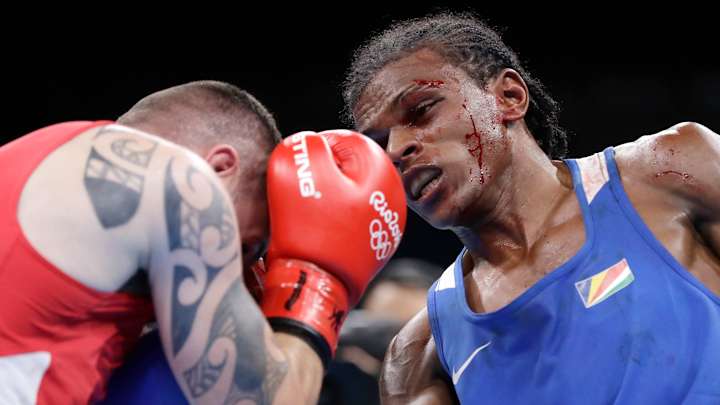Blood and guts: Olympic boxers dealing with facial cuts

RIO DE JANEIRO (AP) Olympic boxing is bloody again.
Men are fighting without headgear for the first time in 36 years, making the sport debatably safer and undoubtedly more attractive to fans. But the most tangible consequence is gore: More than a dozen boxers at the Rio Games have already incurred significant facial cuts in the first six days of the tournament.
Algerian middleweight Ilyas Abbadi was unsure how he got the 1 1/2-inch gash outside his left eye during his victory over Congo's Mpi Ngamissengue on Tuesday, but blood trickled down his face during the bout. The cleaned-up wound still gaped to reveal bloody tissue afterward, and he could only hope his training staff could close it satisfactorily before his next fight Friday.
''Now I know the value of the headgear,'' Abbadi said through a translator. ''I think for the amateurs, that would be better. I would prefer to fight with headgear, but this is how it is.''
The Olympics are the amateur game's biggest showcase by far, and the sport desperately hoped a major cut won't ruin a fighter's hopes through medical disqualification. It happened for the first time Thursday, when a 2-inch cut near Armenian welterweight Vladimir Margaryan's right eye forced the stoppage of his bout with Cuban gold medalist Roniel Iglesias after just 87 seconds.
Margaryan's coach, Karen Aghamalyan, said his fighter already had a cut from his first Olympic bout four days earlier. Ringside physicians couldn't close the gash when it re-opened in the first minute against Iglesias, who was a heavy favorite.
In pro boxing, the sight of blood on a fighter's face and chest is common - and an undeniable part of the sport's primal lure. But that visceral reminder of the sport's inherent violence had been rare in the modern amateur game until the International Boxing Association (AIBA) removed headgear from its fighters in 2013, citing scientific studies claiming protective padding actually increases brain injury.
Although AIBA has worked to improve its boxers' fighting styles to minimize head clashes, cuts have become a steady occurrence at major tournaments ever since, often when two skulls collide in an up-close exchange of punches.
The absence of headgear has led to several grisly, compelling scenes in preliminary bouts.
Russia's Adlan Abdurashidov and Algeria's Reda Benbaziz both were cut Tuesday during their lightweight bout, which was stopped twice in the second round for Abdurashidov to receive medical attention. Blood dripped steadily from Benbaziz's face in the third.
''The guy was using his head a lot, and he received a warning from the judge,'' Benbaziz said after winning the decision despite a 2-inch cut through his right eyebrow, which was already swelling moments after the bout. ''Yeah, it will affect my next fight, but we will have to fight with an injury. I wish I could be using the headguard.''
Abdurashidov could only grimace in frustration, blood caked to his upper chest above his tank top.
''The first minute after the cut, it was very uncomfortable for me,'' Abdurashidov said. ''I took some punches because of my eye. It was from a head-butt. Usually, it's very good to fight without headgear, but today it was a minus. In general, it's better for me without.''
Abdurashidov echoed the feelings of many fighters, who appear to be roughly split on the change. Despite the risk, many boxers prefer the increased peripheral vision and freedom of movement allowed by an uncovered head.
''I don't like getting cut, but I prefer to fight without headgear,'' said Ireland's David Oliver Joyce, who was left bloodied by a clash of heads in his loss to Azerbaijan's Albert Selimov. ''I'm more of a pro-style boxer, and for the past couple of years, the amateur system suited me.''
Amateur boxers began wearing headgear between the 1980 Moscow Games and the 1984 Olympics in Los Angeles. Organizers believed the cushions around the skull and cheeks would cut down on concussions and other serious head injuries, but they also protected fighters from bloody damage, allowing them to compete in a multi-fight tournament with almost no cuts.
With fighters' faces hidden behind bulky padding, the amateur sport gradually lost its long-held status as a must-see Olympic event. The headgear era roughly coincided with the move to a computer-based, punch-counting scoring system.
Both factors contributed to Olympic boxing's evolution into a sometimes plodding sport derided as ''fencing with gloves,'' with fighters rewarded for light punches and elusiveness over power, toughness and combinations.
AIBA has returned to a pro-style scoring system since the London Games. The resulting sport is more attractive in almost every manner, and the bouts in Rio have generally been more compelling - but the blood on the fighters' faces portends a potential problem.
Professional boxers get several months of recovery time between bouts. Olympic boxers must fight up to five times in a nine-day span, with no time for significant cuts to heal in any meaningful way.
So fighters will punch and pray.
Russian bantamweight Vladimir Nikitin bled all over himself while beating Vanuatu's Boe Warawara on Wednesday. A deep cut in the scalp on the left side of Nikitin's head sent blood pouring down his face and neck, but he smiled through the reddened mess when his hand was raised in victory.
Nikitin believes he'll have no problem fighting again Sunday.
